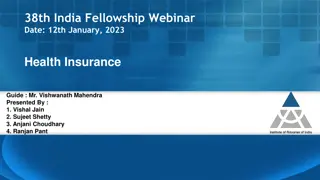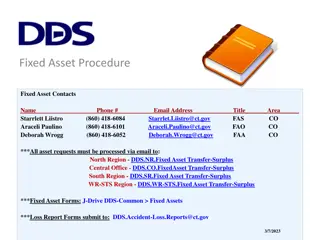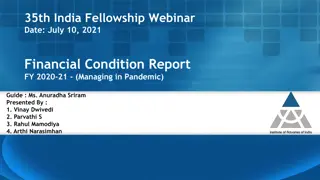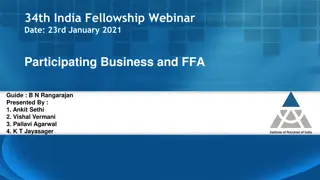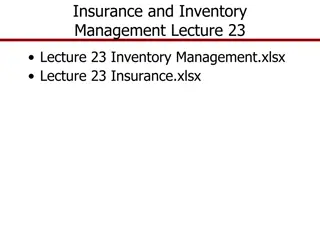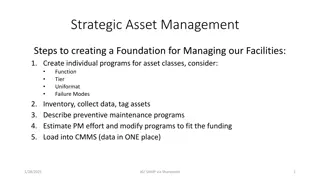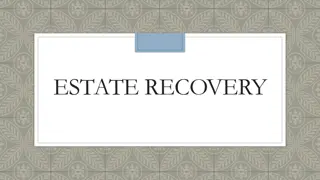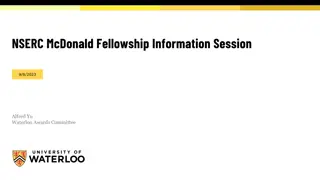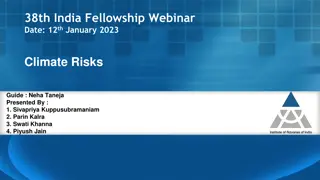Understanding Asset Shares and Estate Management in Insurance: Insights from the 35th India Fellowship Webinar
Delve into the complexities of asset shares and estate management in the insurance industry through the lens of the insightful 35th India Fellowship Webinar. Learn about historical paradigms, regulatory shifts, and available alternatives for insurers in managing asset shares and estate growth. Explore key concepts like asset shares calculation, professional guidance, and the nuances between estate and FFA. Gain valuable perspectives from industry expert Sanchit Maini and contributors Anurag Goyal, Nitin Agarwal, Sumit Dutta, and Tablesh Pandey. Enhance your understanding of policy benefits, financial management, and market dynamics essential for actuarial roles in insurance.
Download Presentation

Please find below an Image/Link to download the presentation.
The content on the website is provided AS IS for your information and personal use only. It may not be sold, licensed, or shared on other websites without obtaining consent from the author. Download presentation by click this link. If you encounter any issues during the download, it is possible that the publisher has removed the file from their server.
E N D
Presentation Transcript
35th India Fellowship Webinar Date: 16 July 2021 Issues in Participating Fund Management Guide : Sanchit Maini Presented By : 1. Anurag Goyal 2. Nitin Agarwal 3. Sumit Dutta 4. Tablesh Pandey
Introduction of Guide: Sanchit Maini Sanchit is an actuary and risk manager having worked in the insurance industry for over 20 years across various firms and actuarial consulting. His experience covers risk management, financial management and reporting, product development and propositions, business planning and market entry. His work experience spans various markets across Asia, the UK, US and France. Sanchit is currently Chief Financial and Operational Risk Officer covering risk management for Prudential s Asia and Africa businesses. Sanchit is a Fellow of the Institute of Actuaries of Australia, India and Singapore (FIAA, FIAI, FSAS) and a Chartered Enterprise Risk Actuary (CERA). www.actuariesindia.org
Background Questions You are WP Actuary in Indian Life Company Q1: Discuss how assetshares & estate are Company historically focused on selling par calculated and any applicable regulations / recent year focus has shifted to non-par guidance notes Very little NB in par over past few years Q2: Discuss why could there be a difference Bonuses largely inline with PRE, set to be between the estate that you have calculated consistent with the bonuses in the point of sale and funds for future appropriations FFA illustrations. Q3: Discuss what alternatives would you Level of Estate has been growing in the fund. consider in managing the situation, identifying With new business declining, chargeable the pros and cons of each of the alternatives expenses being restricted by EoM regulations, actual expenses have been higher than this level. www.actuariesindia.org
Agenda Calculation of Asset Shares & Estate Applicable regulations and Professional Guidance Key similarities and differences between Estate and FFA Alternatives available to insurer with advantages and disadvantages www.actuariesindia.org
Asset Shares Definition Asset Share of a policy is used to define the benefits that the policyholder would receive on the occurrence of an event (surrender, maturity, etc.) Asset share can be broadly stated as the accumulation of monies in less monies out in respect of a policy since the start of the policy till the valuation date www.actuariesindia.org
Asset Shares Calculation Premium income Investment income Allocated Misc. Profit / (Loss) Expenses Commission Cost of benefits Shareholder transfers Cost of capital and guarantees Tax www.actuariesindia.org
Asset Shares Components Premium and Commission are taken on actual basis Expenses are usually taken on steady state basis, although some companies might have used actual expenses in the past Can be based on either the MTM TWRR generated by the par fund or on the book value basis Cost of capital could be allowed using different approaches such as WACC approach, difference between RDR and Shareholder return, etc Tax is usually based on the asset share surplus and not the Company level tax position Shareholder transfers are based on the 1/9th of the cost of policyholder bonus www.actuariesindia.org
Asset Shares Purpose Asset Shares (A/S) have a central role in management of With-Profits business and are the guiding force in: Setting the reversionary as well as terminal bonus rates The final maturity payout is usually determined as some % of the asset shares (e.g. between 95% - 105%) Determination of surrender values to be paid at different durations Also used by some companies in the calculation of reserves www.actuariesindia.org
Applicable Regulations Clause 34(iv) of Non Linked Product Regulations 2019 The insurer shall ensure maintenance of the Assets Share. The detailed working of the asset share, the expenses allowed for in the asset share, the investment income earned on the fund and other associated elements which are represented in the asset share shall be determined by the Appointed Actuary. www.actuariesindia.org
Applicable Regulations Clause 34(v) of Non Linked Product Regulations, 2019 The With Profit committee report shall at least cover Appropriateness of the Methodology and basis used in calculation of asset shares, and justification for any change. Clause 21 of Non Linked Product Regulations, 2019 The special surrender value shall represent the asset share in case of the par policies, where the asset share shall be determined in accordance with the guidance or practice standards issued by the Institute of Actuaries of India. www.actuariesindia.org
Professional Guidance Guidance Note 6 AA to consider the following while computing Asset Share Whether appropriate to group policies Various sources of surplus & their treatment in Asset Share or Estate Whether to consider miscellaneous profits (such as surrender profits / losses) to Asset Share or Estate Whether an explicit allowance for cost of guarantees in Asset Share AA to consider Fairness and appropriateness of approach adopted Documenting and sharing the same with the Board and Regulator www.actuariesindia.org
Estate Definition and Calculation Estate is a term used for the excess realistic assets over the realistic liabilities within the par fund Estate It can also be seen as the amount of assets in the par fund in excess of the Asset share Realistic Assets Realistic Liabilities Estate can be thought as the amount of assets in the Par Fund over which there is no reasonable expectations from any cohort of policyholders www.actuariesindia.org
Estate Sources of surplus Drivers of Estate build up include S/H capital injections to fund New Business Strain, expense over-runs, solvency in initial years Sources of surplus not attributed to asset shares (e.g. Surrender profits, tax recoveries) Charges such as cost of capital and cost of guarantees Inherited estate Resulting from under-distribution in respect of past generations of with-profit policyholders and that there is no policyholder from that past generation remaining with the company Acquired as part of merger or acquisition from the past www.actuariesindia.org
Estate Uses The estate can be used by the company to demonstrate the on-going solvency requirement of with-profits business and other lines of businesses It also provides investment flexibility by enabling a higher proportion of investment in higher risk assets (equity, property etc.) with potentially higher returns in the long run It also helps in supporting the new business strain arising out of sale of future with-profits policies in the par fund www.actuariesindia.org
Estate & Funds for Future Appropriation Estate Computation Statutory Balance Sheet Items Estate FFA Realistic Assets Statutory Assets Statutory Liabilities Realistic Liabilities FFA* = Assets less Statutory Liabilities Estate = Realistic Assets less Realistic Liabilities * In IRDAI (Preparation of Financial Statements and Auditor s Report of Insurance Companies) FFA shall represent all funds, the allocation of which, either to the policyholders or to the shareholders, has not been determined by FY end.
FFA & Estate Key Similarities FFA and Estate, even though not being the same, are often used interchangeably since: They are both considered to be assets in excess of the policyholder liabilities These are considered as additional assets that may be distributed to the shareholders through policyholder bonuses through 90:10 gate. However, estate reattribution may be carried out to effectively transfer the Estate to shareholders, potentially up-to 100% after appropriate legal, external actuarial advice with a Court process to adjudicate such a transfer. They both serve similar purposes such as providing solvency support for the par fund and business, additional investment freedom, smoothening of bonuses, writing more new business, etc. www.actuariesindia.org
Estate & FFA Key Differences Funds for Future Appropriation Estate FFA can be seen and calculated from the Statutory Balance Sheet The calculation of estate will be more internal to the Company and cannot be seen from the Statutory Balance Sheet FFA includes surplus which might not be a part of the statutory reserves, but some part of it is expected to be utilized for policyholder payments and thus will form part of PRE Estate will typically not form part of PRE Company may look to distribute benefits reflecting policy s / policy grouping s Asset Share and may use part of FFA (i.e. Asset Share less Reserves) as the basis to determine the distribution Company is not expected to distribute the estate to participating policyholders but may make alternate uses, e.g. investment income on estate may be used for smoothening of bonuses The valuation methodology defined in IRDAI regulations drives the calculation of FFA. For estate computations, Assets may be valued on a market value basis to ascertain available funds on a realistic basis www.actuariesindia.org
Estate & FFA Sources of Surplus Funds for Future Appropriation Estate Experience variances such as investment, mortality, persistency, expense overrun, etc. Some part of the lapse / surrender profits, particularly if the initial expenses were funded by shareholder injections Shareholder injections to the par fund to either fund new business, support solvency, support bonuses or expenses of management regulations Some part of these shareholder injections can be considered as a part of estate Taxation surplus on account of losses from other funds of the Company Some part of the taxation surplus can also be considered as estate, particularly if this has resulted due to other lines of business Some part of the same can be considered in the estate Investment income on the shareholder injections Inherited estate on account of some Merger & Acquisition of another par fund in the past www.actuariesindia.org
Alternatives to manage the situation The following alternatives can be considered and deployed in isolation or in combination to manage the situation 1. Change in NB Strategy Introduce new par product Increase par product new business mix 2. Existing Business Management Review par fund management strategy to improve bonus Expense management 3. Review investment strategy to improve par fund yield 4. Risk Management www.actuariesindia.org
Change in New Business Strategy (I) Introduction of new par products Targeted to specific customer needs; eg child education, retirement, legacy planning, wealth transfer, etc. Offer higher returns to appeal to customers looking for higher total returns through non-par traditional plans Benefit design may be defined backed by well researched customer needs to compete well against competition Limitations May reduce non-par product mix, resulting in overall reduction in profit margin May take longer to launch, not an immediate solution www.actuariesindia.org
Change in New Business Strategy (II) Explore new bonus approaches Introduce new bonus option like cash bonus (US style dividends) or flexibility to surrender the RB creating liquidity Review shape of bonuses, for instance with lower bonus in first 2-3 years and higher thereafter Higher levels of RB than existing products (higher guarantees) to increase product attractiveness Higher level of TB while reducing RB to reduce NB strain, reserves and guarantees Limitations/ Further Considerations Setting and managing Policyholder Reasonable Expectation for new generation of products www.actuariesindia.org
Change in New Business Strategy (III) Move business from products with similar margins into par Business from ULIP segment may be moved to par Distribution remuneration may be aligned to incentivize par Offer higher commission to par compared to non-par Business moved from ULIP could enable higher commissions in par Increase sale of higher PPT products, higher case size etc. Limitations/ Further Considerations ULIP has a natural customer pull which may make mix movement to par difficult Increased solvency cost when business moved from ULIP www.actuariesindia.org
Existing Business Management (I) Review (improve) bonus distribution strategy and use it to increase new business in par Align bonus and exit payouts (surrender/death/maturity) with asset share Asset share to liability ratio target in a range of ~90% to ~110% Re-target Free Asset Ratio in a range to guide bonus declaration Bonus distribution granular enough by product types/cohorts Limitations/ Further Considerations Might reduce estate growth or even shrink it Parity between policyholders from different cohorts www.actuariesindia.org
Existing Business Management (II) Asset shares: Include all sources of surplus in asset share on actual experience, like surplus from surrender, riders, RPU conversion to improve policyholder benefits through higher asset shares Improve RB and/or TB on existing products open to new business Improve persistency of the in-force policies for higher expense allowable Limitations Higher RB will impact the reserves www.actuariesindia.org
Existing Business Management (III) Expense Management Explore outsourcing of activities as permitted by regulations to control overall costs With changes in business mix, expense unitizations would change from previous years may lead to expense savings in par book Target lower overall total costs Office space Expense like travel, entertainment etc. People cost related Greater digital and automation adoption Limitations/ Further Considerations Putting expense controls may be mired in execution challenges www.actuariesindia.org
Investment Strategy Consider increasing strategic asset allocation to higher risk assets such as equities, property to enhance long term returns in the par fund Expand asset classes Such as alternate investment funds, REITS / InvITs This will provide opportunities to improve returns to both policyholders and shareholders through increased bonuses Limitations Increased volatility of surpluses in the short / medium term and therefore the SAA exercise would need to establish the optimal risk/ reward trade-off www.actuariesindia.org
Risk Management Non Par Savings as a category has higher volatility of profit margins from shareholder s perspective for instance under falling interest rate economic environment Balanced savings product strategy with sizeable proportion of participating business or other products that share risk between policyholders and shareholders (eg ULIP, Universal Life) may be advisable for effective interest rate risk management www.actuariesindia.org
Conclusion (I) Considerations for Company Management Improving Expense Ratios: Options such as the use of shared services, outsourcing working within the regulatory framework. Reallocating and Reducing staff, Reducing per policy expense, increasing number of policies Persistency Improvements at all durations-Improvements in sales practices and training, Special Revival Campaigns for improving persistency, Incentives to Intermediary for higher persistency, Claw back Commissions if policy lapses Bonus declarations in line with Board Approved bonus Principles and Philosophy (or consider amendments to the policy) taking considerations of all stakeholders, Changing proportion of RB v/s TB over the long term, Eligibility of Reversionary Bonus for New Business after two or three years., and for Terminal Bonus after five or Ten years Impact of decisions (systems, people, costs, readiness, distribution, financial outcomes being targeted, impact on customers etc.) www.actuariesindia.org
Conclusion (II) Wider stakeholder alignment There has to be a discussion with the various stakeholders and the major changes in strategy have to be discussed in various committees like Product Recommendation Committee The With-Profits Committee Risk Management Committee of the Board Based on the deliberations and approvals these Committees Management would present the final Strategy to the Board of the Company for Approval. www.actuariesindia.org
Conclusion (III) Consultation & Agreement with Board Adjustments in Investment Strategy leveraging on the cushion available in the par fund and utilizing the funds from the RB v/s TB strategy over the years. A long term investment strategy to generate higher returns. Adjustment in Product Strategy -Diversification of the product portfolio and designing new products to cater to various target segments. Also looking at withdrawing products which are loss making or not contribute meaning fully. These strategies have to be approved at the Board level and the management has to take a view based on the relative advantages and limitations discussed in the slides. www.actuariesindia.org


